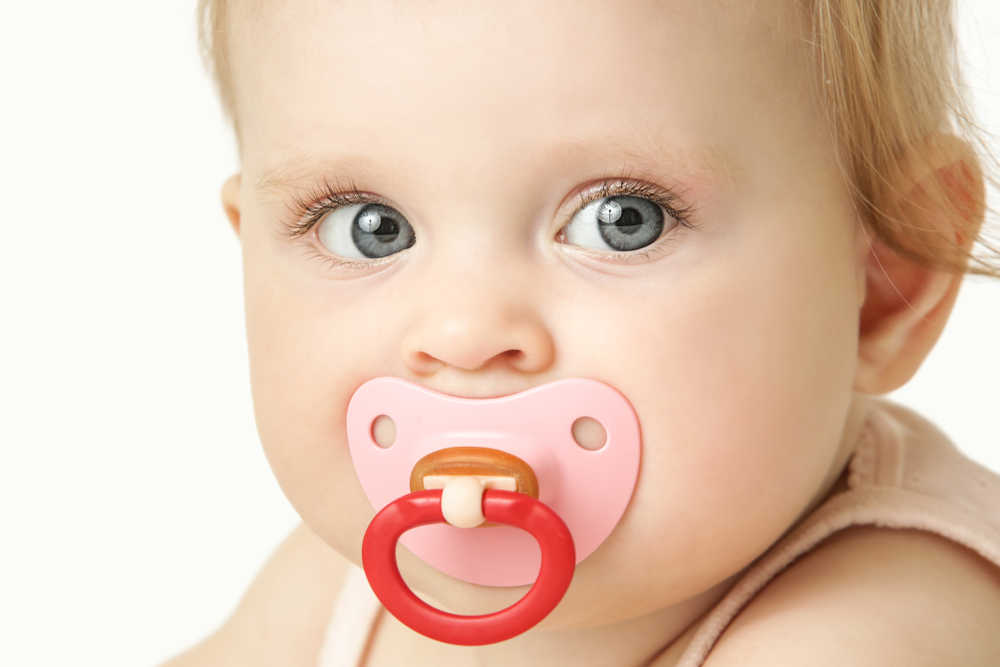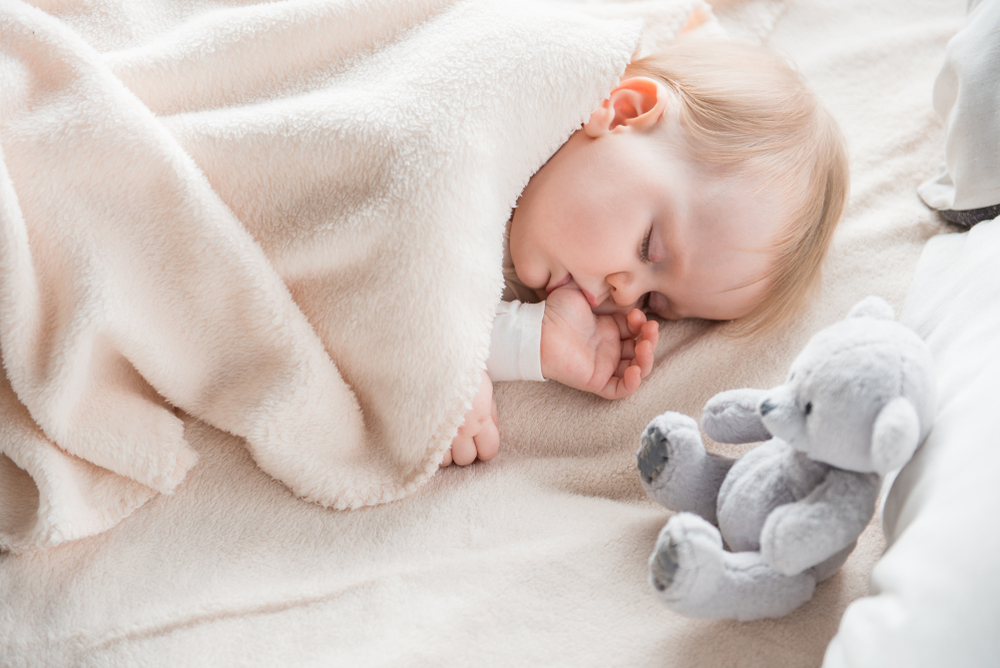
There are so many different opinions when it comes to the two most common oral habits: thumb sucking and using a pacifier. “Never give your baby a pacifier.” “Offer a pacifier as soon as possible, so they don’t suck their thumb.” “Take away the pacifier when they turn 1.” “Break that thumb sucking habit by age 2.” Phew. It’s a lot to navigate as a parent!
Well, we tapped into Dr. Hawley’s orthodontic expertise and personal experience (he’s a dad of four) to put together a research-based guide on the topic. Read on for all of the details you need to make an informed decision that works for your family.
Pacifier Use and Thumb Sucking in Babies (Spoiler: It’s Totally Normal!)
We know a lot of parents ask themselves, “Should I stop my baby from sucking their thumb?” But, babies are born with a natural sucking reflex. According to John Hopkins Medicine, “about 90% of newborns show some form of hand sucking by 2 hours after birth.” Pacifier use is common too. The American Academy of Family Physicians reports that approximately 75 to 85% of kids in Western countries use a pacifier during infancy.
That means the vast majority of infants suck their thumbs, fingers or a pacifier at one point or another in their first year of life. Putting things in their mouths is a way babies explore and learn about the world around them. Sucking habits also help infants self-soothe.
Thumb sucking in babies is perfectly fine and part of the developmental process. Offering an infant a pacifier is also absolutely okay. In fact, studies show that pacifier use during sleep reduces the risk of Sudden Infant Death Syndrome (SIDS). If you’re nursing and have concerns about giving your baby a pacifier, talk with your pediatrician so you can get personalized guidance for your situation.
How Do Pacifiers and Thumb Sucking Affect Teeth?
While sucking on a pacifier, thumb or fingers during infancy (birth to 1 year of age) is fine and, in the case of pacifiers, may be beneficial, prolonged oral habits can have consequences.
The good news is, most kids stop thumb sucking or using a pacifier on their own between the ages of two and four. If they continue the habit or they suck constantly or vigorously (you might hear a popping noise when they take their thumb or pacifier out of their mouth), orthodontic issues are more likely to occur. The habits can interfere with facial and jaw growth, causing skeletal and dental changes that lead to different types of malocclusion (bad bite).
The most common problems are:
- Protruding Front Teeth – Sucking on a thumb or pacifier puts pressure behind the front teeth, which may make them tilt or stick out. Protruding front teeth, sometimes referred to as pacifier teeth or buck teeth, are more susceptible to injury, can cause speech problems and may make it difficult to comfortably close the lips and mouth.
- Crossbite – A crossbite is when some of the top teeth sit inside of the bottom teeth. A patient can have an anterior crossbite (front crossbite) or posterior crossbite (back crossbite). When a crossbite is caused by thumb sucking or pacifier use, it’s generally a posterior crossbite, resulting from a narrowing of the upper arch. Not only can crossbites lead to jaw pain and uneven wear of the enamel, patients also often compensate by shifting their jaw to one side, which can further cause mismatched jaw growth.
- Open Bite – A patient is said to have an open bite if their top teeth don’t overlap their bottom teeth when the jaw is closed. In some cases, the teeth don’t touch at all, leaving an opening or space between the upper and lower arch. An open bite can cause speech, swallowing and chewing difficulties.
Are Orthodontic Pacifiers Really Better Than Regular Ones?
Traditional pacifiers usually have a rounded nipple. The nipple of a functional or orthodontic pacifier, on the other hand, is flat on the bottom. An orthodontic pacifier is designed to mimic nursing and is supposed to encourage the natural movement of an infant’s tongue.
A 2018 systematic review of studies found that orthodontic pacifiers appear to reduce the risk of an open bite as compared to conventional pacifiers, though the authors stated that more well-designed, randomized control trials are needed. However, there wasn’t enough research to conclude whether orthodontic pacifiers prevent a posterior crossbite.
The bottom line: The verdict is still out, but orthodontic pacifiers might be effective for preventing an open bite when compared to regular pacifiers.
What Age Should Kids Stop Oral Habits?
The most severe orthodontic problems tend to happen when kids continue to use a pacifier or suck their thumb when their permanent teeth are ready to erupt. However, issues can develop earlier than that, especially if kids use a pacifier or suck their thumb or fingers daily and/or aggressively.
Here’s where the research stands:
- A meta-analysis in the International Journal of Orthodontics concluded that pacifier use beyond age 3 causes a higher incidence of anterior open bite, posterior crossbite, a narrow upper arch and a high, narrow palate. These effects became even more severe in children who used a pacifier after age 5.
- Several studies, including one published in the Journal of the American Dental Association, found that the most significant malocclusion occurred in kids who continued their sucking habit beyond 4 years of age. However, the effects of thumb sucking and pacifier use were seen in some children as early as 24 months.
- Another study also confirmed that malocclusion could occur in kids who continued using a pacifier after 24 months, particularly if they also engaged in mouth breathing.
So, what age should you try to stop a child’s pacifier of thumb sucking habit? The American Dental Association recommends these oral habits be discouraged if they continue past age 4, while the American Academy of Pediatric Dentistry says intervention could be necessary after age 3.
Based on the research, starting to gently encourage little ones to give up their pacifier or stop sucking their thumb, or at least decrease the frequency, around age 2 or 3 would be ideal. If you’re not able to get your child to stop the habit by age 4, be sure to speak with your pediatric dentist about the issue.
How to Stop Thumb Sucking or Break a Pacifier Habit
While a pacifier habit is often easier to break, because you can take it away unlike a thumb, there are still plenty of options to eliminate a thumb sucking habit. Keep in mind, a common reason for thumb sucking and pacifier use is self-soothing, so kids can be a little grumpy as you try to transition away from the habit. This usually only lasts a few days and their smile will thank you!
Here are some helpful tips for how to stop thumb sucking or break a pacifier habit:
- Talk to your child about the habit and why they eventually need to stop it. However, don’t turn it into a power struggle. Try empowering them to break the habit themselves by telling them you’ll be there to help them when they’re ready to give it up. Since, as we said, most kids do stop on their own, even just broaching the subject might be enough to get the ball rolling.
- Use positive reinforcement. Criticizing the habit or pulling their thumb out of their mouth can make kids more anxious and more likely to continue. Instead, praise them whenever you notice they go any length of time without sucking on their thumb or pacifier.
- Set up a system of rewards. For example, use a sticker chart to highlight the times your child doesn’t engage in the habit. When they reach a predetermined number of stickers, give them a prize, whether it’s an extra episode of their favorite show, a trip to the park, choosing where to order takeout for dinner, or whatever you think will motivate your little one.
- If you prefer a gradual approach, you can start by limiting how often your child sucks their thumb or uses their pacifier. With a pacifier, simply take it away during pacifier-free times. A thumb is trickier and will require some gentle encouragement.
First, explain to them they can only suck their thumb or have their pacifier in the house and not in public. Next, transition to only at bedtime. Eventually, you can take the pacifier away altogether or start encouraging them to give up thumb sucking completely.
- If you’d rather go cold turkey with the pacifier, talk with your child in advance and tell them the pacifier will be going away. If you’re afraid they’ll have trouble sleeping without it, you could always hype up a new “big kid” bedtime. Maybe get some fun new sheets, introduce a cozy blanket or stuffed friend or let them pick out a new pair of pajamas. On the date you specified, get rid of all of their pacifiers and celebrate their new big kid bedtime setup or routine.
- Habits can be subconscious, especially thumb sucking. Your child might not even realize they have their thumb in their mouth. Help them cultivate self-awareness by asking, “Hey, did you know you’re sucking your thumb?” Then, offer other options like a stuffed animal or a toy.
- It’s common for kids to suck their thumb when they’re anxious, upset or stressed. Try to get to the bottom of why they’re feeling that way and devise a plan together of what they can do instead, whether it’s cuddling with mom and dad, going for a walk or talking about what’s bothering them.
- Never underestimate distraction. If your tiny tot is having a particularly rough day and is very cranky or going back to the habit, turn their attention elsewhere. Break out paper and crayons, play a game or get outside for a change of scenery.
- If your child sucks their thumb when they’re bored, keep their hands busy. Depending on their age, things like fidget toys, doodling, Play-Doh or puzzles can help occupy their hands.
- Enlist the help of your dentist. If nothing seems to be working, ask your child’s pediatric dentist about how to stop thumb sucking or break a pacifier habit. They’ll be able to offer guidance and talk with your child. Sometimes, hearing something from someone who’s not a parent can be helpful.
- In the case of vigorous, prolonged thumb sucking that lasts beyond age 3 or 4 or is starting to cause dental issues, a habit-breaking appliance could be necessary. These appliances stop the thumb from coming into contact with the palate and prevent suction, which takes away the enjoyment.
Can the Effects of Thumb Sucking or a Pacifier be Fixed?
Yes! If your child has dental issues from thumb sucking or using a pacifier, the issues can be fixed. The American Association of Orthodontists recommends kids have their first orthodontic evaluation by age 7 or at the first sign of an orthodontic problem.
At this stage, your child will still be growing and have some baby teeth. If needed, our Papillion orthodontist can use certain appliances to guide jaw growth during phase 1 orthodontic treatment. After a resting period, your child will start phase 2 treatment with braces or Invisalign® Teen.
While not every child needs two-phase orthodontic treatment, for those who do, especially if sucking their thumb or a pacifier has caused skeletal changes, the approach can help prevent the need for jaw surgery or extractions. It will also make treatment in their teen years easier, faster and more affordable.
If your child missed the window for early orthodontic intervention, it’s still not too late to correct the problem. Dr. Hawley can create a personalized treatment plan using braces or Invisalign, typically along with auxiliaries like rubber bands, to straighten teeth and align the bite at any age.
Connect With an Orthodontist in Papillion, NE
At Hawley Orthodontics, we treat patients of all ages, including kids! If you’re concerned about the effects of thumb sucking or a pacifier on your child’s teeth, schedule a complimentary consultation with our Papillion, NE orthodontist. Dr. Hawley will examine your child, determine an accurate diagnosis and work with you to give them a healthy, beautiful smile.




